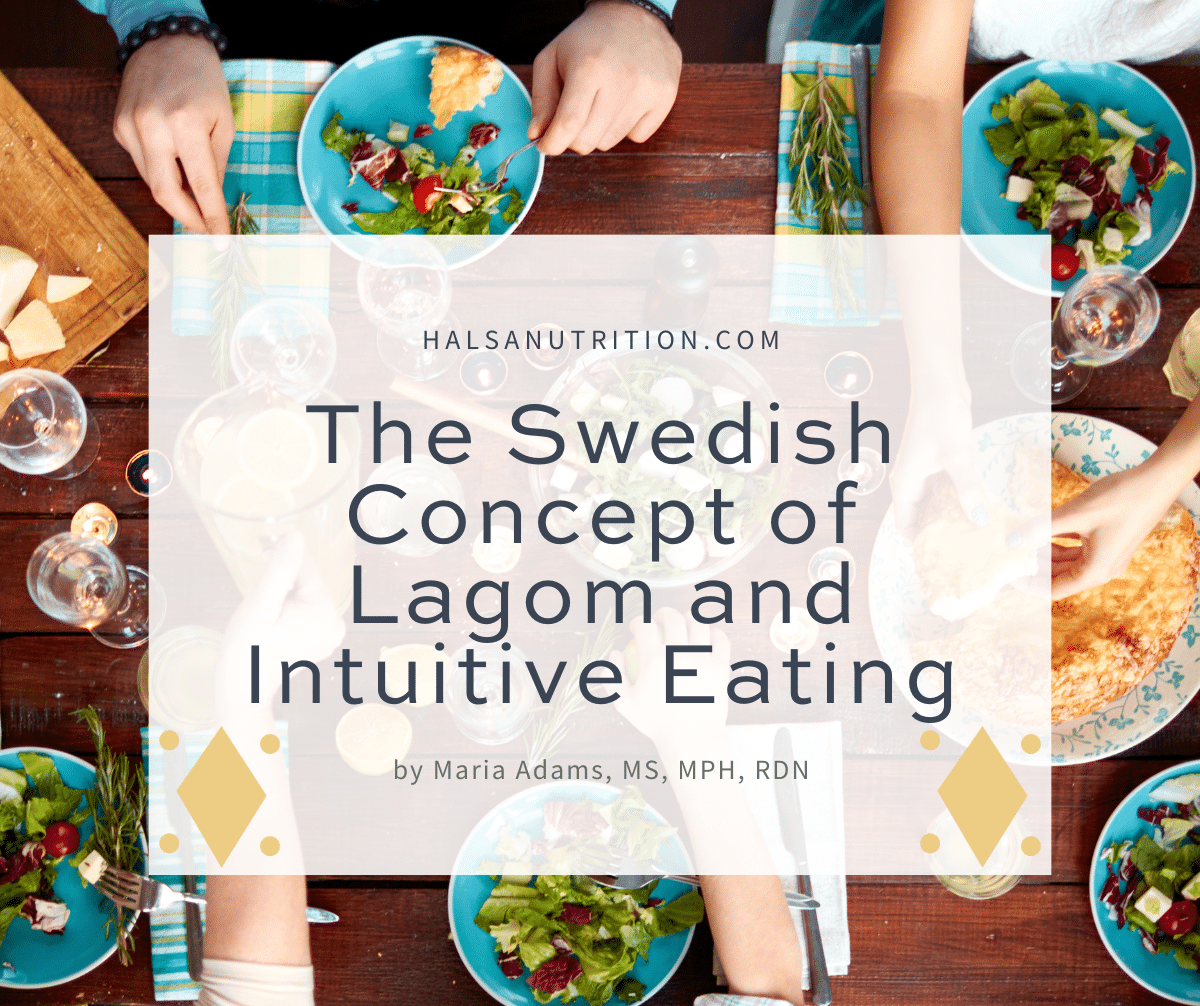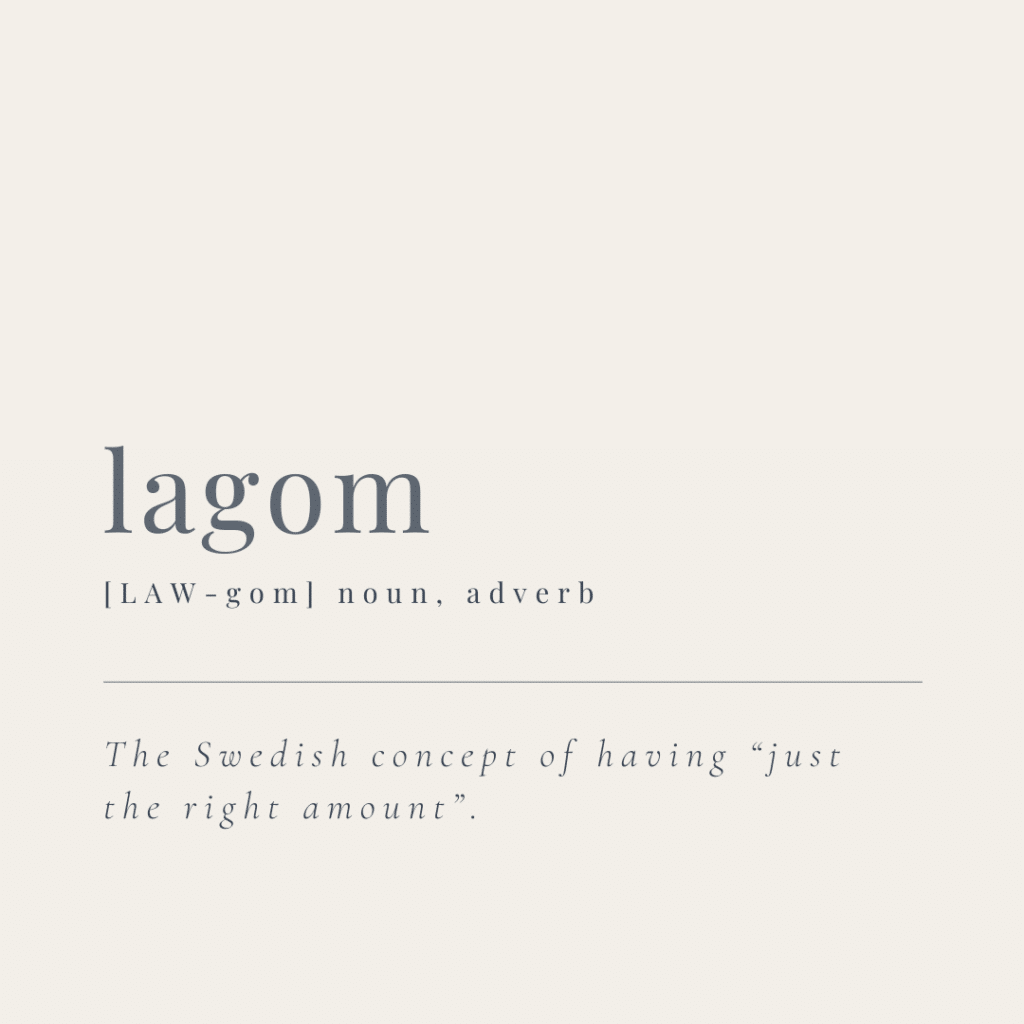
The Swedish Concept of “Lagom” and Intuitive Eating
Estimated reading time: 6 minutes
Lagom is a Swedish word and concept that means “just the right amount.” Interestingly enough, this concept has a lot in common with intuitive eating.
What is lagom?
Lagom means having “just the right amount”. It can be thought of as the feeling of contentment–or satisfaction–you get when you have all you need. This can be applied to food, exercise, material goods, and money. It’s the idea that more of something isn’t necessarily going to lead to greater contentment. For example, we may think that we will be happier if we have more clothes, more cake, or more beauty. But in reality, we are more likely to find true contentment when we have just enough.

Just like resisting diet culture is hard to do in this day and age, embracing lagom and being okay with “just enough” is hard to do in our society. We often think of success as “being the best” or “having the most”. But yet we know that these factors don’t guarantee happiness. Moreover, if you have the “I need to be more” mentality you are likely to never feel like you’re enough. (And a reminder: you are enough just as you are!)
How does the concept of lagom relate to intuitive eating?
Intuitive eating is an approach to eating that entails tuning into your body’s physical and emotional cues as well as honoring your wisdom and lived experiences. At the hub of intuitive eating is satisfaction. It’s said that all principles of intuitive eating revolve around satisfaction.
Satisfaction can be defined as “the act of fulfilling a need, desire, or appetite, or the feeling gained from such fulfillment” as well as “you’ve had enough, in a good way.” (Vocabulary.com) As you can see, this is a very similar concept to lagom.

Whether we are talking about hunger and fullness, movement, gentle nutrition, or body respect, they all relate to satisfaction–and therefore lagom. For example, as the Intuitive Eating book and workbook tell us:
- Eating when we are a little hungry–versus ravenously hungry or not hungry at all–leads to more satisfaction.
- Likewise, eating until comfortably full leads to more satisfaction and contentment than eating until overly full and uncomfortable.
- Learning to quiet the critical/negative voices in your head (aka the food police) will lead to greater satisfaction because it makes eating much more enjoyable and satisfying.
- Moving your body regularly in a way that feels good will lead to much more life satisfaction in the long run than doing exercise that you don’t enjoy just because it’s supposed to be good for you.
- Similarly, you could discover that a 20-minute walk or run feels better and more satisfying to your body than a 45-minute walk or run–and that’s okay. More isn’t necessarily better–we need to find what feels good to us. (And this could also mean realizing that walking feels lagom for you–you don’t have to run).
The concept of lagom also adheres to the “most of the time” mentality of intuitive eating
A key component of becoming an intuitive eater is embracing the “most of the time” mentality. With diet culture, we often see statements such as “eat 5 vegetables every day,” “avoid foods with added sugar”, or “never miss a day of exercise”.
While eating veggies, cutting back on added sugar, and exercising are positive health behaviors for many–when we take them to the absolute or extreme they are the opposite of good. For one, these kinds of rules are incredibly hard to stick with and set us up for the “all-or-nothing mentality.” This mentality makes it easy to completely quit your healthy intentions when you “break” one rule. Two, these kinds of rules completely ignore what intuitive eating is all about–which is listening to and responding to your body’s cues with kindness. And three, these kinds of rules lead to disordered eating.
The concept of lagom is a great reminder that when it comes to nutrition, exercise, and overall well-being, it’s about finding what works for you–especially what satisfies you and is “just enough”. Like the intuitive eating “most of the time” mentality, lagom is not extreme. It’s about meeting you where you are right now and finding the balance in what you have and do. When you tune into what is lagom, you may realize that it’s different from the general guidelines or the diet culture rules.

How the concept of lagom relates to other aspects of life that affect health and well-being
The concept of lagom can also be applied to life in general. It’s about being content with what you have right now and not getting wrapped up in consumerism or trying to keep up with the Joneses.
Whether you would like to apply the concept of lagom to eating or other aspects of your life, working on intuitive eating and practicing mindfulness can help. Both will help you become more aware of your current habits and thoughts, while also learning to lean into the present moment and what you truly need.
Aiming for more day-to-day joy and contentment can also help. What are some small changes that you can make to improve your quality of life right now? Perhaps it’s getting outside on most days. Maybe it’s adding more hygge and mys to your day with fika. Or perhaps it’s aiming for more work-life balance–a lagom amount of work–and resolving to spend evenings and weekends relaxing, not working or overly connected to your phone.
Other posts you might like
- Meal Satisfaction: 12 Ways to Increase It
- Letting Go of the Diet Mentality
- 7 Key Concepts of Mindful Eating
- 21 Ways to Add Hygge and Mys to Your Day
- Discover the Joy of Intuitive Eating
- The Hunger Fullness Scale
About the Author
Maria Adams, MS, MPH, RDN, LDN, a registered dietitian and Certified Intuitive Eating Counselor. Maria helps individuals rediscover the joy of food and eat to feel their best by healing from chronic dieting and disordered eating. She holds a Bachelor of Science Degree in Nutrition Science, a Master of Science in Nutrition Communication, and a Master of Public Health.
Leave a Reply